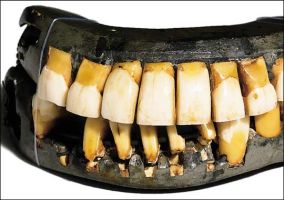
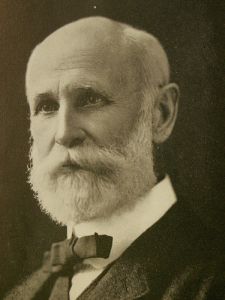
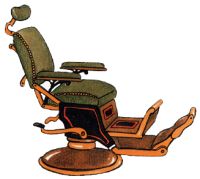
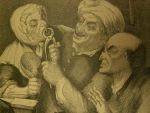
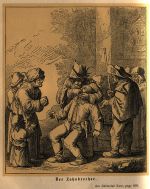
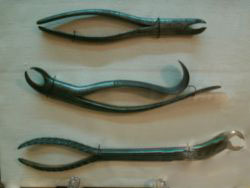
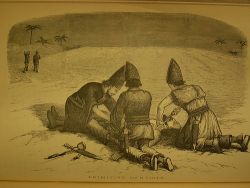
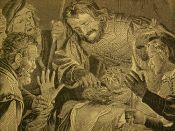
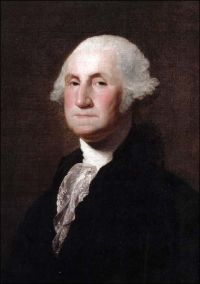
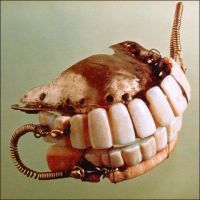
20th Century history
1997—FDA approves the erbium YAG laser, the first for use on dentin, to treat tooth decay.
1990s—New tooth-colored restorative materials plus increased usage of bleaching, veneers, and implants inaugurate an era of esthetic dentistry.
1989—The first commercial home tooth bleaching product is marketed.
1980s—Per-Ingvar Branemark describes techniques for the osseointegration of dental implants.
1962—Rafael Bowen develops Bis-GMA, the thermoset resin complex used in most modern composite resin restorative materials.
1960—The first commercial electric toothbrush, developed in Switzerland after World War II, is introduced in the United States. A cordless, rechargeable model follows in 1961.
1960s—Sit down, four-handed dentistry becomes popular in the U.S. This technique improves productivity and shortens treatment time.
1960s—Lasers are developed and approved for soft tissue procedures.
1958—A fully reclining dental chair is introduced.
1957—John Borden introduces a high-speed air-driven contra-angle handpiece. The Airotor obtains speeds up to 300,000 rotations per minute and is an immediate commercial success, launching a new era of high-speed dentistry.
1957 —The Social Security Act is amended to include self-employed dentists.
1955—Michael Buonocore describes the acid etch technique, a simple method of increasing the adhesion of acrylic fillings to enamel.
1950s—The first fluoride toothpastes are marketed.
1949—Oskar Hagger, a Swiss chemist, develops the first system of bonding acrylic resin to dentin.
1948—President Harry S. Truman signs the Congressional bill formally establishing the National Institute of Dental Research and initiating federal funding for dental research. The name changes to National Institute of Dental and Craniofacial Research (NIDCR) in 1998.
1945—The water fluoridation era begins when the cities of Newburgh, New York, and Grand Rapids, Michigan, add sodium fluoride to their public water systems.
1940s—22,000 dentists serve in World War II.
1938—The nylon toothbrush, the first made with synthetic bristles, appears on the market.
1937—Alvin Strock inserts the first Vitallium dental screw implant. Vitallium, the first successful biocompatible implant metal, had been developed a year earlier by Charles Venable, an orthopedic surgeon.
1933—The first National Board dental examinations are conducted. 83 candidates are examined in 4 cities.
1930—The American Board of Orthodontics, the world’s first dental specialty board, is founded.
1930–1943—Frederick S. McKay, a Colorado dentist, is convinced that brown stains (mottling) on his patients’ teeth are related to their water supply. McKay’s research verifies that drinking water with high levels of naturally occurring fluoride is associated with low dental caries and a high degree of mottled enamel. By the early 1940s, H. Trendley Dean determines the ideal level of fluoride in drinking water to substantially reduce decay without mottling.
1928—National Board of Dental Examiners is established.
1926—The Carnegie Foundation-sponsored Gies Report, the first comprehensive report on the state of dental education, is published and has an immediate impact on the dental profession.
1924—American Dental Assistants Association is founded by Juliette Southard and her female colleagues. Female dental assistants were first hired in the 19th century when “Lady in Attendance” signs were routinely seen in the windows of dental offices. Their duties included chair-side assistance, instrument cleaning, inventory, appointments, bookkeeping, and reception.
1923—American Association of Dental Schools is established.
1917—Irene Newman receives the world’s first dental hygiene license in Connecticut.
1913—Alfred C. Fones opens the Fones Clinic For Dental Hygienists in Bridgeport, Connecticut, the world’s first oral hygiene school. Most of the twenty—seven women graduates of the first class are employed by the Bridgeport Board of Education to clean the teeth of school children. The greatly reduced incidence of caries among these children gives impetus to the dental hygienist movement. Dr. Fones, first to use the term “dental hygienist,” becomes known as the Father of Dental Hygiene.
1911—The U.S. Army Dental Corps is established as the first armed services dental corps in the U.S. The Navy institutes its Dental Corps in 1912.
1910—The first formal training program for dental nurses is established at the Ohio College of Dental Surgery by Cyrus M. Wright. The program is discontinued in 1914 mainly due to opposition by Ohio dentists.
1908—Greene Vardiman Black, the leading reformer and educator of American dentistry, publishes his monumental two-volume treatise Operative Dentistry, which remains the essential clinical dental text for fifty years. Black later develops techniques for filling teeth, standardizes operative procedures and instrumentation, develops an improved amalgam, and pioneers the use of visual aids for teaching dentistry.
1907—William Taggart invents a “lost wax” casting machine, allowing dentists to make precision cast fillings.
1905—Alfred Einhorn, a German chemist, formulates the local anesthetic procain, later marketed under the trade name Novocain.
1903—Charles Land devises the porcelain jacket crown.
1900—Fifty-seven dental schools exist by this year.
1900—Federation Dentaire Internationale (FDI) is formed.
19th Century
1899—Edward Hartley Angle classifies the various forms of malocclusion. Credited with making orthodontics a dental specialty, Angle also establishes the first school of orthodontics (Angle School of Orthodontia in St. Louis, 1900), the first orthodontic society (American Society of Orthodontia, 1901), and the first dental specialty journal (American Orthodontist, 1907).
1895—Wilhelm Roentgen, a German physicist, discovers the x-ray. In 1896 prominent New Orleans dentist C. Edmond Kells takes the first dental x-ray of a living person in the U.S.
1890—Willoughby Miller an American dentist in Germany, notes the microbial basis of dental decay in his book Micro-Organisms of the Human Mouth. This generates an unprecedented interest in oral hygiene and starts a world-wide movement to promote regular toothbrushing and flossing.
1890—Ida Gray, the first African-American woman to earn a dental degree, graduates from the University of Michigan School of Dentistry.
1890—Almost 100 dental societies are established by this year.
1887—Stowe & Eddy Dental Laboratory, the first successful industrial-type laboratory in the U.S., opens in Boston, marking the ascendancy of the modern commercial dental laboratory. The earliest known dental laboratory in the U.S. was Sutton & Raynor which opened in New York City around 1854.
1880—Twenty-eight dental schools are established by this year.
1880s—The collapsible metal tube revolutionizes toothpaste manufacturing and marketing. Dentifrice had been available only in liquid or powder form, usually made by individual dentists, and sold in bottles, porcelain pots, or paper boxes. Tube toothpaste, in contrast, is mass-produced in factories, mass-marketed, and sold nation-wide. In twenty years, it becomes the norm.
1877—The Wilkerson chair, the first pump-type hydraulic dental chair, is introduced.
1871—The American George F. Green receives a patent for the first electric dental engine, a self-contained motor and handpiece.
1871—James B. Morrison patents the first commercially manufactured foot-treadle dental engine. Morrison’s inexpensive, mechanized tool supplies dental burs with enough speed to cut enamel and dentin smoothly and quickly, revolutionizing the practice of dentistry.
1871 -The first electric dental engine, a self-contained motor and handpiece.
1869—Dr. Robert Tanner Freeman, graduating from Harvard University Dental School, becomes the first African-American to earn a dental degree.
1867—The Harvard University Dental School, the first university-affiliated dental institution, is founded. The school calls its degree the Dentariae Medicinae Doctorae (DMD), creating a continuing semantic controversy (DDS vs. DMD).
1866—Lucy Beaman Hobbs graduates from the Ohio College of Dental Surgery, becoming the first woman to earn a dental degree.
1864— Sanford C. Barnum, develops the rubber dam, a simple device made of a piece of elastic rubber fitted over a tooth by means of weights, which solves the problem of isolating a tooth from the oral cavity.
1859—Twenty-six dentists meet in Niagara Falls, New York, and form the American Dental Association. (See the ADA Timeline for more information).
1855—Robert Arthur originates the cohesive gold foil method allowing dentists to insert gold into a cavity with minimal pressure. The foil is fabricated by annealing, a process of passing gold through a flame making it soft and malleable.
1844—Horace Wells, a Connecticut dentist, discovers that nitrous oxide can be used as an anesthesia and successfully uses it to conduct several extractions in his private practice. He conducts the first public demonstration of its use as an anesthetic in 1845 but the demonstration is generally considered a failure after the patient cries out during the operation. In 1846, another dentist (and a student of Wells), William Morton, takes credit for the discovery when he conducts the first successful public demonstration of the use of ether as an anesthesia for surgery. Crawford Long, a physician, later claims he used ether as an anesthetic in an operation as early as
1842, but he did not publish his work.
1841—Alabama enacts the first dental practice act, regulating dentistry in the United States.
1840—The American Society of Dental Surgeons, the world’s first national dental organization, is founded. (The organization dissolves in 1856.)
1840—Horace Hayden and Chapin Harris establish the world's first dental school, the Baltimore College of Dental Surgery, and originate the Doctor of Dental Surgery (DDS) degree. (The school merges with the University of Maryland School of Dentistry in 1923).
1839—The American Journal of Dental Science, the world’s first dental journal, begins publication.
1839—Charles Goodyear invents the vulcanization process for hardening rubber. The resulting Vulcanite, an inexpensive material easily molded to the mouth, makes an excellent base for false teeth, and is soon adopted for use by dentists. In 1864 the molding process for vulcanite dentures is patented, but the dental profession fights the onerous licensing fees for the next twenty-five years.
1833–1850—The Crawcours (two brothers from France) introduce amalgam filling material in the United States under the name Royal Mineral Succedaneum. The brothers are charlatans whose unscrupulous methods spark the “amalgam wars,” a bitter controversy within the dental profession over the use of amalgam fillings.
1832—James Snell invents the first reclining dental chair.
1825—Samuel Stockton begins commercial manufacture of porcelain teeth. His S.S. White Dental Manufacturing Company establishes and dominates the dental supply market throughout the 19th century.
1801—Richard C. Skinner writes the Treatise on the Human Teeth, the first dental book published in America.
18th Century
1790—Josiah Flagg, a prominent American dentist, constructs the first chair made specifically for dental patients. To a wooden Windsor chair, Flagg attaches an adjustable headrest, plus an arm extension to hold instruments.
1790—John Greenwood, son of Isaac Greenwood and one of George Washington’s dentists, constructs the first known dental foot engine. He adapts his mother’s foot treadle spinning wheel to rotate a drill.
1789—Frenchman Nicolas Dubois de Chemant receives the first patent for porcelain teeth.
1768-1770—Paul Revere places advertisements in a Boston newspaper offering his services as a dentist. In 1776, in the first known case of post—mortem dental forensics, Revere verifies the death of his friend, Dr. Joseph
Warren in the Battle of Breed’s Hill, when he identifies the bridge that he constructed for Warren.
1760—John Baker, the earliest medically-trained dentist to practice in America, immigrates from England and sets up practice.
1760-1780— Isaac Greenwood practices as the first native-born American dentist.
1746—Claude Mouton describes a gold crown and post to be retained in the root canal. He also recommends white enameling for gold crowns for a more esthetic appearance.
1723—Pierre Fauchard, a French surgeon publishes The Surgeon Dentist, A Treatise on Teeth (Le Chirurgien Dentiste). Fauchard is credited as being the Father of Modern Dentistry because his book was the first to describe a
comprehensive system for the practice of dentistry including basic oral anatomy and function, operative and restorative techniques, and denture construction.
Ancient History
100 BC—Celsus, a Roman medical writer, writes extensively in his important compendium of medicine on oral hygiene, stabilization of loose teeth, and treatments for toothache, teething pain, and jaw fractures.
166-201 AD—The Etruscans practice dental prosthetics using gold crowns and fixed bridgework.
500-300 BC—Hippocrates and Aristotle write about dentistry, including the eruption pattern of teeth, treating decayed teeth and gum disease, extracting teeth with forceps, and using wires to stabilize loose teeth and fractured jaws.
1700-1550 BC—An Egyptian text, the Ebers Papyrus, refers to diseases of the teeth and various toothache remedies.
2600 BC—Death of Hesy-Re, an Egyptian scribe, often called the first “dentist.” An inscription on his tomb includes the title “the greatest of those who deal with teeth, and of physicians.” This is the earliest known reference to a person identified as a dental practitioner.
5000 BC—A Sumerian text of this date describes “tooth worms” as the cause of dental decay.
